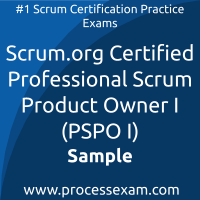01. What is a Product Backlog?
(choose the best answer)
a) It is a list of references to Use Case documents that are stored in a central repository. The references should be viewable and clickable by anybody to enhance transparency.
b) It is a formally approved list of requirements to be implemented over a set period.
c) It is a detailed list of functionality from which the Development Team draws items, to be complemented by a separate Technology Backlog managed by the Development Team.
d) It is a living artifact of product requirements that exists and evolves as long as a product exists.
02. When can the Product Backlog be updated?
(choose the best answer)
a) Never, unless agreed to by the change request
b) At any time when done by the Product Owner or at the Product Owner's discretion
c) Only after a Sprint Review if agreed to by the stakeholders
d) Only during Product Backlog refinement sessions if the Product Owner is present
03. A Product Owner is entitled to postpone the start of a new Sprint after the conclusion of a previous Sprint for the following reason:
(choose the best answer)
a) The Product Owner has not identified a Sprint Goal.
b) The Quality Assurance department needs more time to make the previous Increment "Done".
c) There is no acceptable reason. A new Sprint starts immediately after the conclusion of the previous Sprint.
d) Not enough Product Backlog items are "Ready".
e) The stakeholders are not happy with the value produced in the previous Sprint.
04. To what extent does technical debt limit the value a Product Owner can get from a product?
(choose the best two answers)
a) The velocity at which new functionality can be created is reduced when you have technical debt.
b) Technical debt causes a greater percentage of the product's budget to be spent on maintenance of the product.
c) Technical debt does not influence the delivery of value.
d) Technical debt is not a Product Owner concern, because technical debt is only an issue for the Development Team.
05. What two things best help the Product Owner manage the value of a product?
(choose the best two answers)
a) Devising a formula for a neutral calculation of value
b) Setting value on individual Product Backlog items using Value Poker
c) The order of the Product Backlog
d) Validating assumptions of value through frequent releases
06. What pre-conditions must be fulfilled in order to allow Sprint Planning to begin?
(choose the best answer)
a) Enough "Ready" Product Backlog to fill the Sprint
b) A clear but negotiable business objective for the Sprint
c) A clear and non-negotiable Sprint Goal
d) Formal budget approval to conduct another Sprint
e) A fully refined Product Backlog
f) There are no such pre-conditions
07. The Development Team finds out during the Sprint that they aren't likely to build everything they forecast. What would you expect a Product Owner to do?
(choose the best answer)
a) Re-negotiate the selected Product Backlog items with the Development Team to meet the Sprint Goal.
b) Cancel the Sprint.
c) Change the Sprint Goal.
d) Inform management that more resources are needed.
e) Skip Product Backlog refinement activities.
08. Who is accountable for the estimation of Product Backlog items?
a) The Scrum Team
b) The Developers
c) The Product Owner
d) The Product Owner and the Product Manager
09. What two things should be done if the Product Owner is unavailable?
(choose the best two answers)
a) In a permanent state of unavailability, a new Product Owner needs to be appointed. Development efforts without a Product Owner are not employing Scrum.
b) Within the Sprint, the Development Team makes the best decisions possible to assure progress toward the Sprint Goal, re-aligning with the Product Owner once he/she is available again.
c) Development of functional requirements stops until the Product Owner is available again.
d) There should be a Product Owner team to allow a different person from that team to instantly take over the role of Product Owner.
10. When should the Sprint Goal be formed?
a) Before Sprint Planning so that the team can start planning
b) During the previous Sprint during the Product Backlog refinement session
c) At any time throughout the Sprint
d) A Sprint Goal is not required in Scrum
e) During the Sprint Planning session
 You have to pass the PSPO I exam to receive the certification from Scrum.org. To increase the effectiveness of your study and make you familiar with the actual exam pattern, we have prepared this Scrum.org Professional Scrum Product Owner sample questions. Our Sample Scrum.org Professional Scrum Product Owner I Practice Exam will give you more insight about both the type and the difficulty level of the questions on the Scrum.org PSPO 1 exam.
You have to pass the PSPO I exam to receive the certification from Scrum.org. To increase the effectiveness of your study and make you familiar with the actual exam pattern, we have prepared this Scrum.org Professional Scrum Product Owner sample questions. Our Sample Scrum.org Professional Scrum Product Owner I Practice Exam will give you more insight about both the type and the difficulty level of the questions on the Scrum.org PSPO 1 exam.